How to Use Slack Speech-to-Text: A Quick Guide

Sorry, there were no results found for “”
Sorry, there were no results found for “”
Sorry, there were no results found for “”

Slack is reliable for fast communication, until your hands are full, you’re mid-task, or typing out long updates starts slowing you down. If you’ve ever thought, ‘I could’ve said that in five seconds,’ you’re not wrong.
Voice-to-text is both a convenience and a productivity hack for remote workers, team leads, and anyone moving between tasks.
In this blog post, we’ll show you how to make Slack speech-to-text work. As a bonus, we’ll also show you how ClickUp offers smarter ways to communicate, automate, and get things done.
Let’s get started! 🏁
Yes, you can use voice-to-text in Slack, but it requires a little help from third-party tools.
While Slack lets you send audio and video Clips, and even adds basic transcripts to them, it does not yet let you dictate a message and send it as text. However, you can still send messages using your device’s voice dictation tools, such as Gboard on Android or Siri dictation on iOS and macOS.
With the right tools and a few smart workarounds, you can dictate Slack messages or even convert audio into text.
🧠 Fun Fact: Turns out, your voice can beat your thumbs any day. People using speech recognition on their phones clocked in around 150 words per minute, while typing barely hit 50. And here’s the kicker: they also made fewer mistakes while talking than typing.
You can dictate messages using voice messaging tools on your device. Here’s how to get it working on both desktop and mobile.
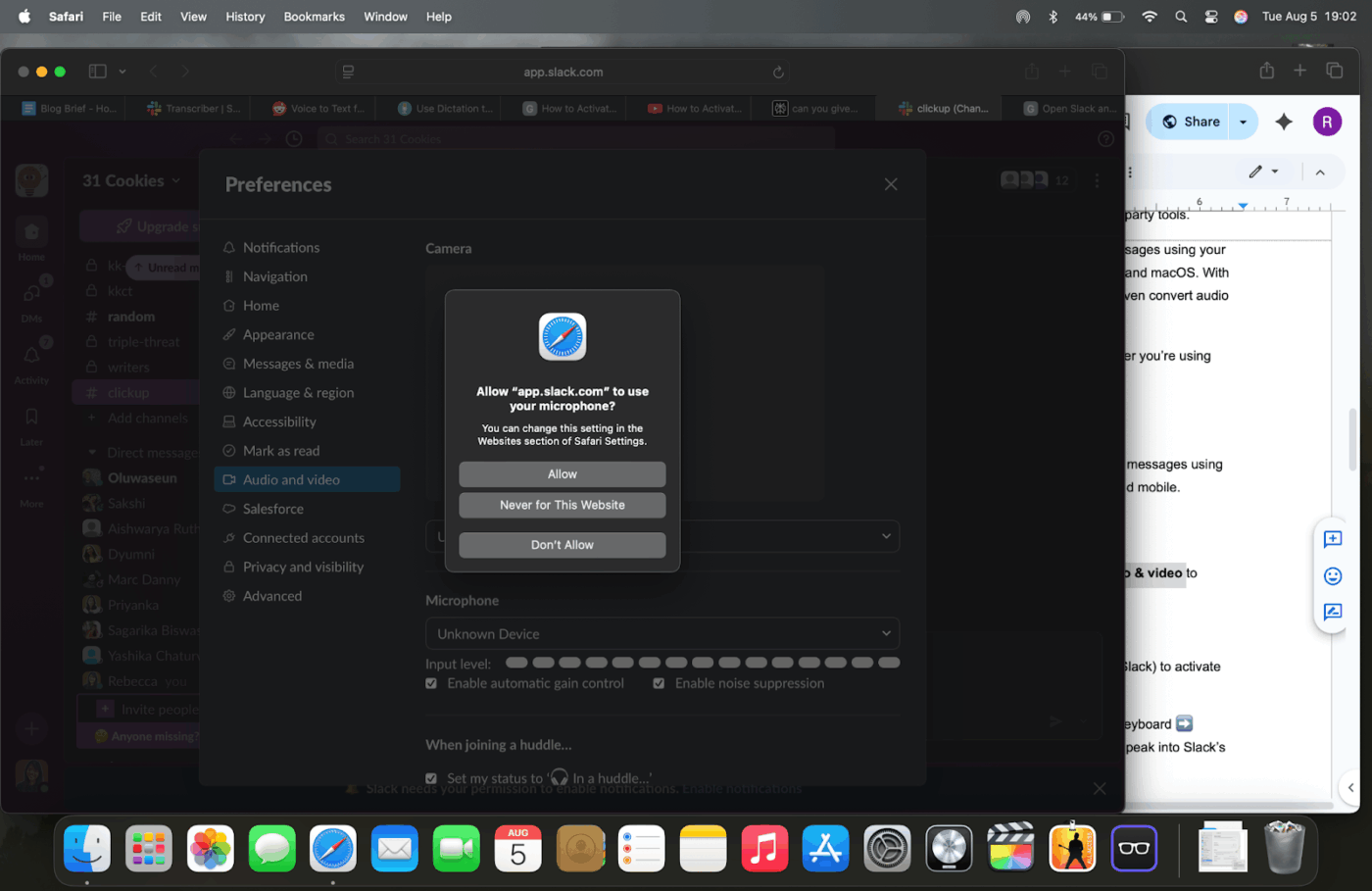
Use your device’s voice dictation keyboard. Open Slack, tap a message field, tap the microphone icon on your mobile keyboard, then speak. Your words convert into transcribed text instantly.
💡 Pro Tip: Record voice notes during virtual meetings using Slack mobile + voice typing, then paste the transcribed summary directly into the meeting thread while on the go.
Slack’s voice message feature is handy when you want to share thoughts on the go. Here’s how to use it on both desktop and mobile:
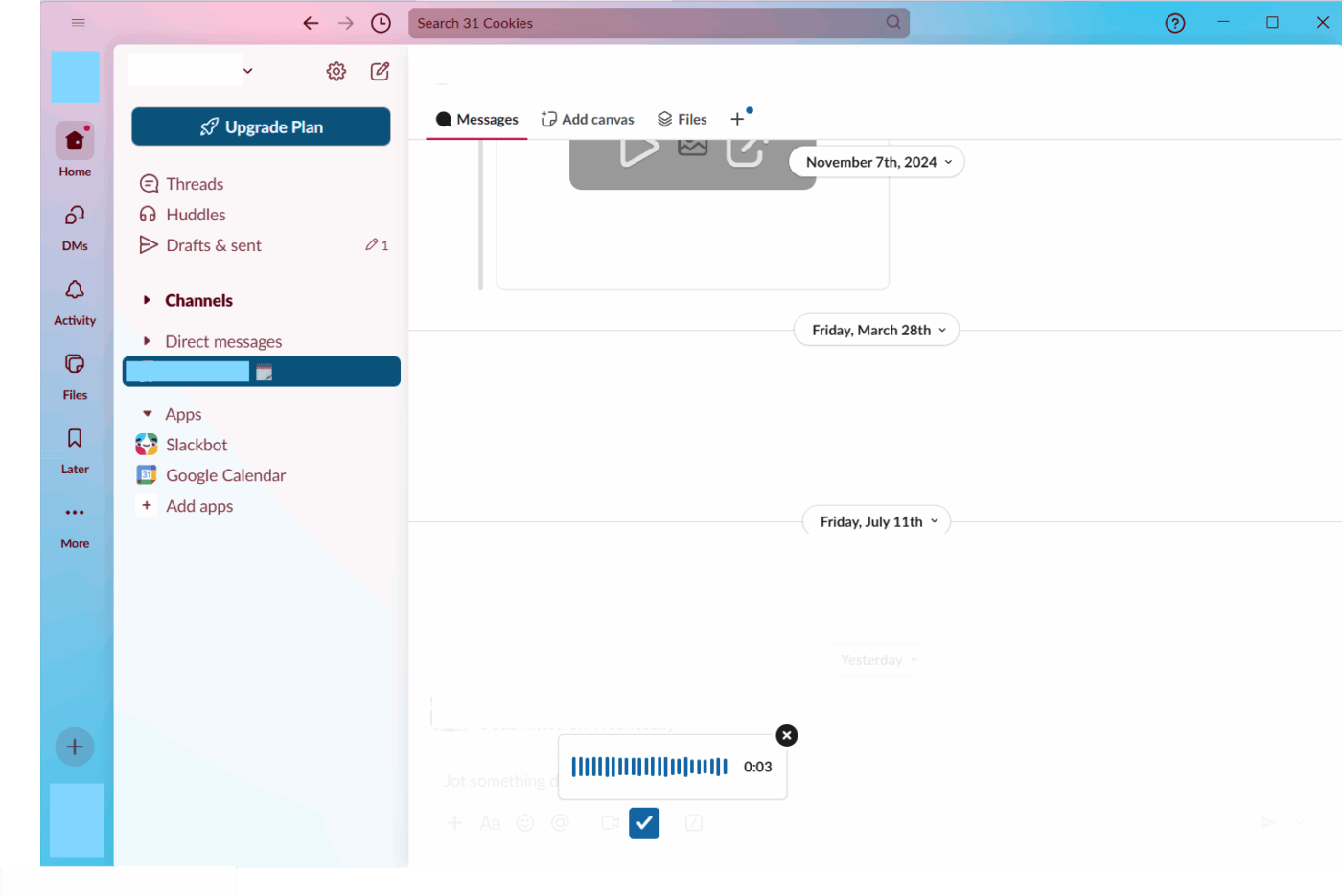
📮 ClickUp Insight: Only 10% of our survey respondents use voice assistants (4%) or automated agents (6%) for AI applications, while 62% prefer conversational AI tools like ChatGPT and Claude. The lower adoption of assistants and agents could be because these tools are often optimized for specific tasks, like hands-free operation or specific workflows.
ClickUp brings you the best of both worlds. ClickUp Brain serves as a conversational AI assistant that can help you with a wide range of use cases. On the other hand, AI-powered agents within ClickUp Chat channels can answer questions, triage issues, or even handle specific tasks!
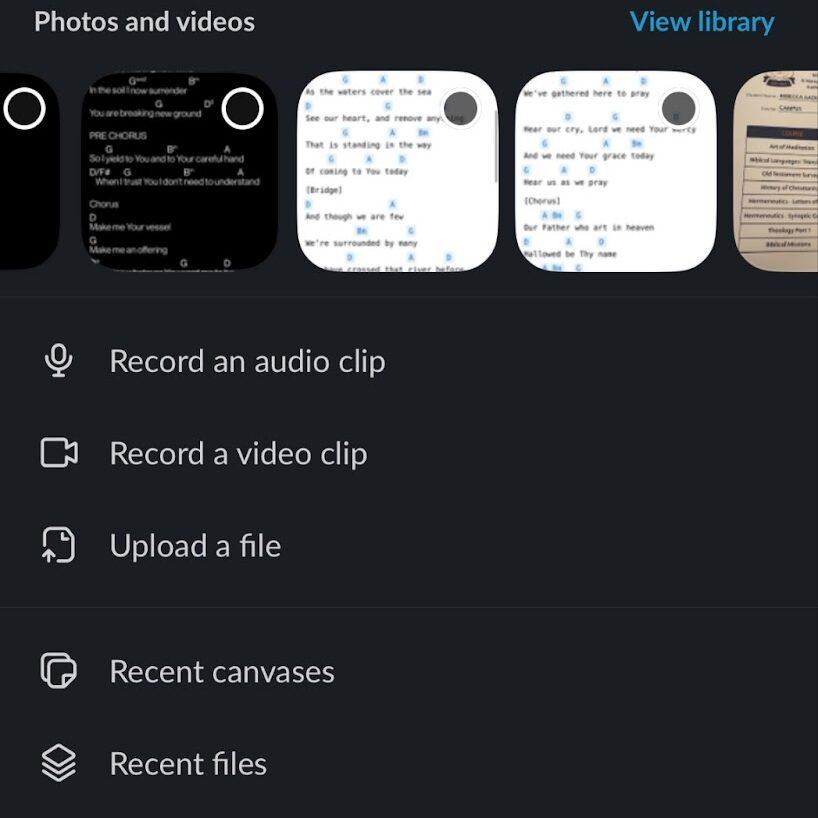
💡 Pro Tip: Dictate quick sprint check-ins or blockers into Slack right after stand-ups to capture fresh context and reduce meeting fatigue.
Transcribing voice messages in Slack can help you quickly capture spoken updates, share meeting notes, or review information without replaying audio. Slack offers a basic built-in transcription feature, but it’s limited in functionality.
If you need more control, third-party speech-to-text software or transcription services can fill the gap.
Let’s break down both methods so you can choose what works best for your workflow.
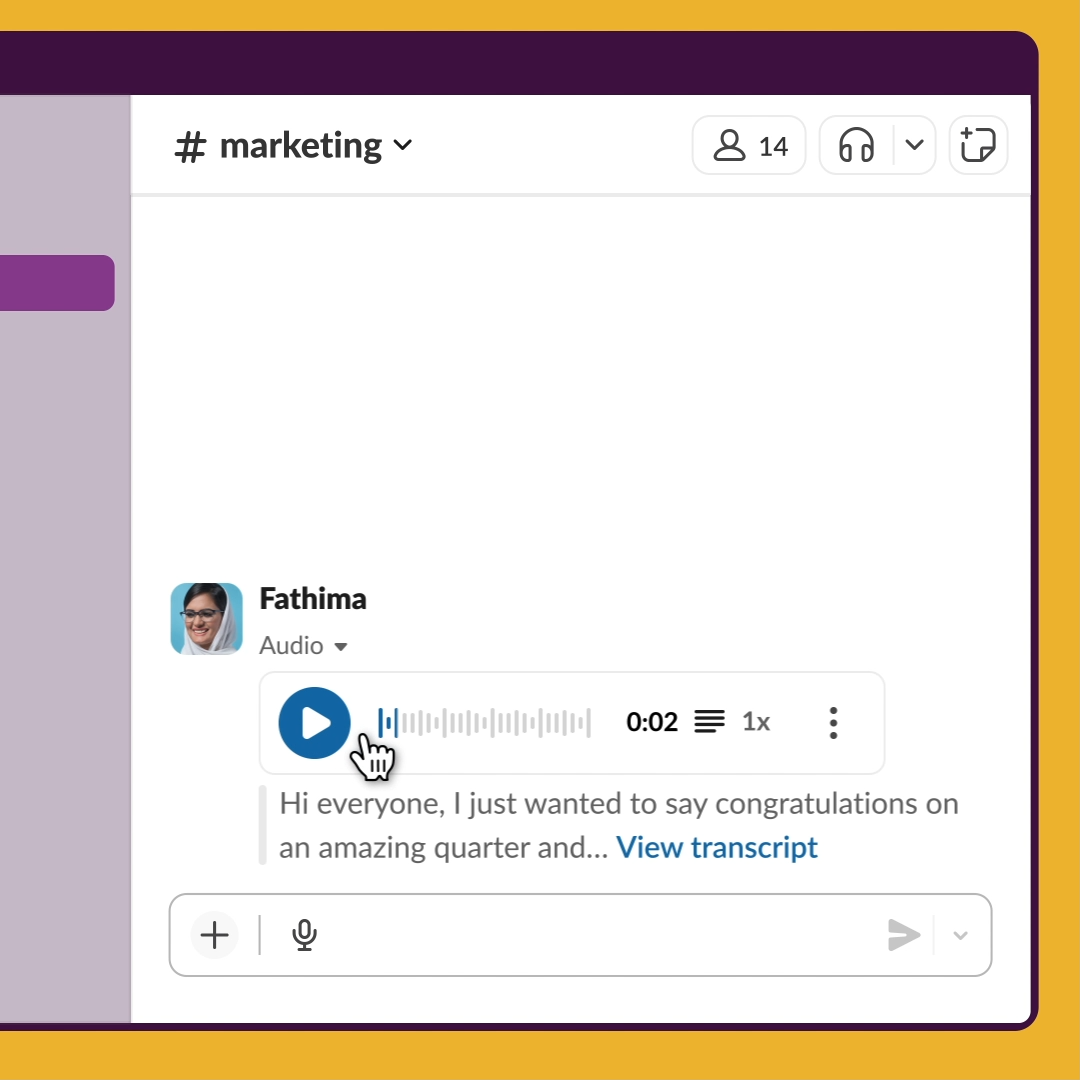
That’s it. You get the basic transcript, and that’s about as far as Slack takes it. There’s no export button, no editing options, and no support for multiple languages or formats.
💡 Pro Tip: Start your voice input with a keyword like ‘action,’ ‘note,’ or ‘decision’ to help listeners and highly accurate transcription tools quickly grasp the intent of your message.
If you want to go beyond these Slack problems, the Transcriber app is a solid upgrade. It plugs right into your Slack workspace and brings powerful AI transcription features to the table.
Here’s how to set it up and start using it:
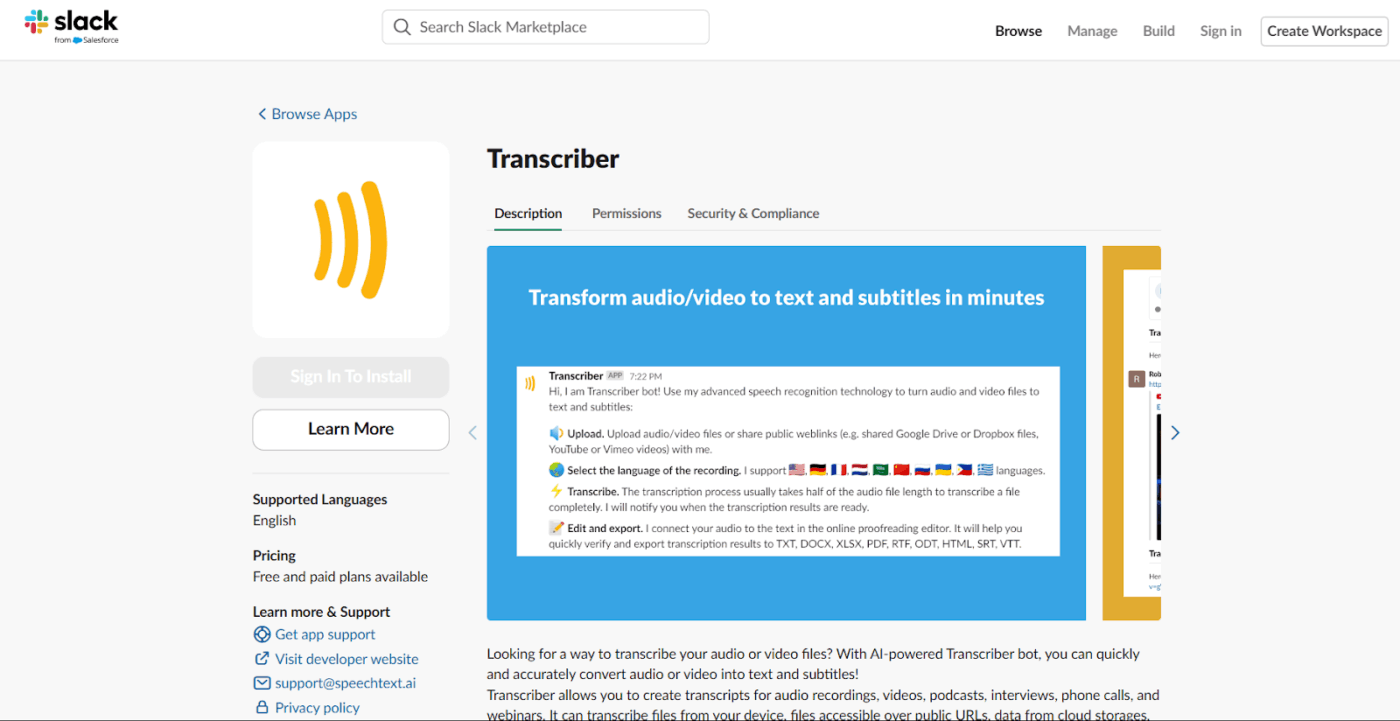
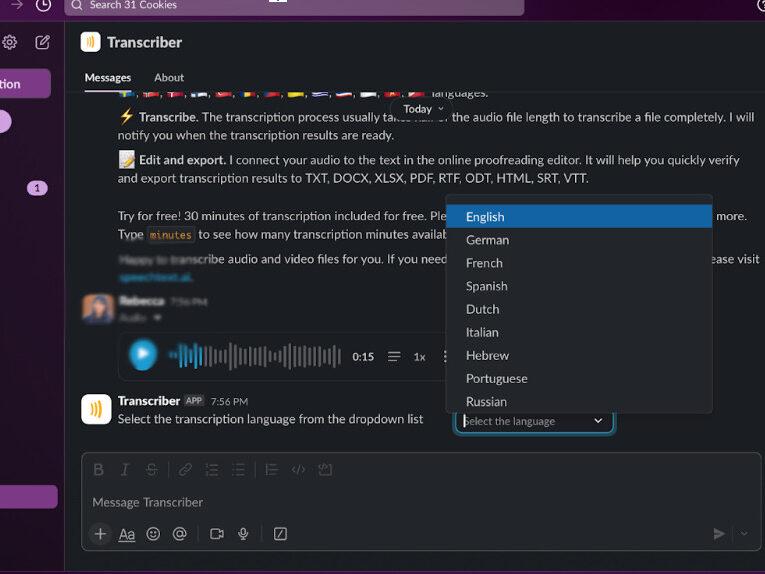
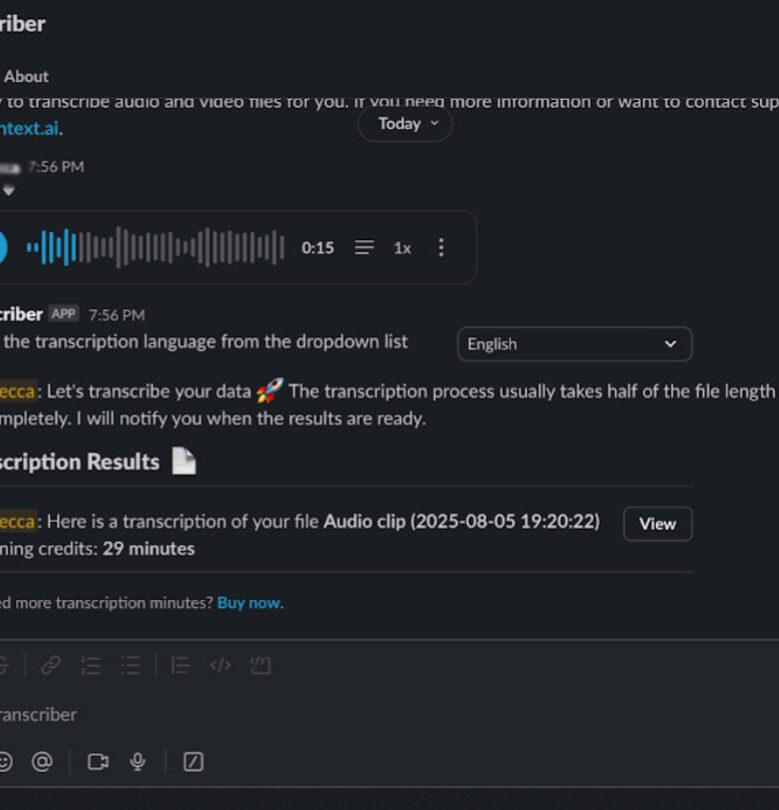
From there, you can:
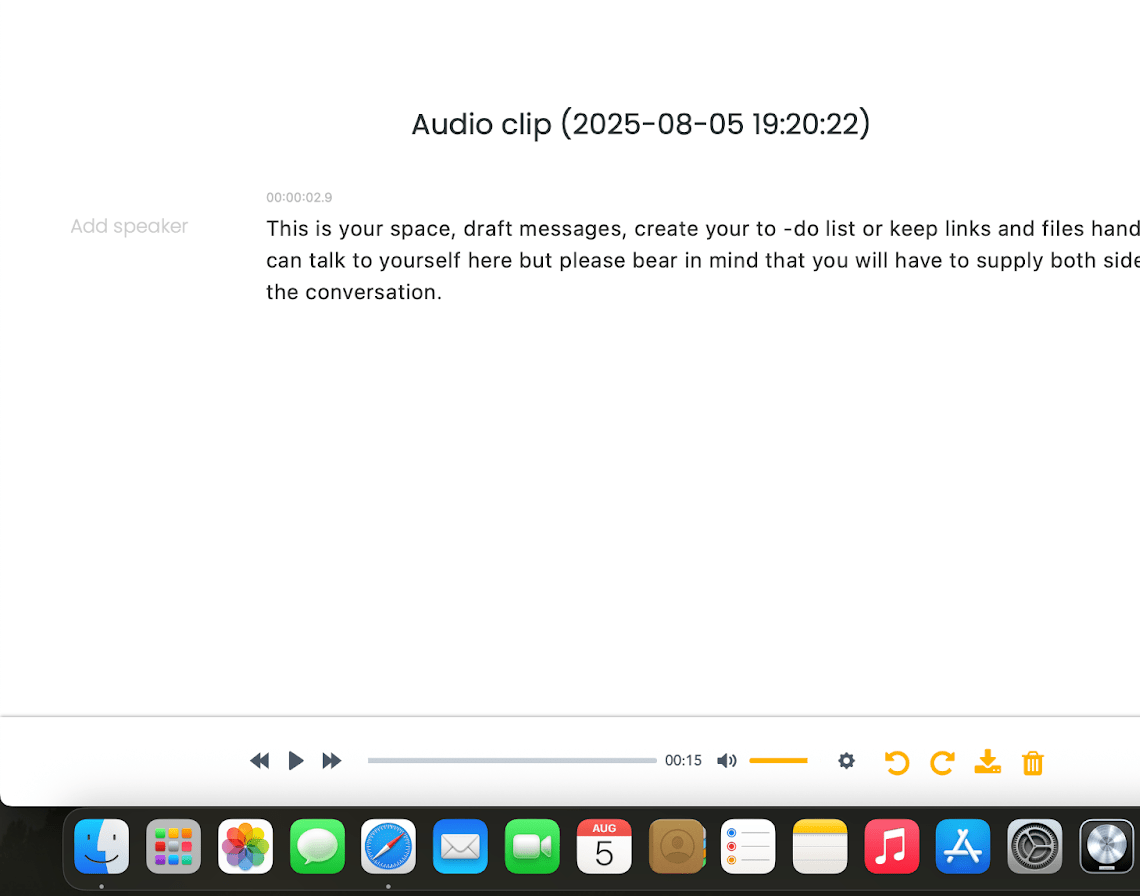
🔍 Did You Know? In mental health settings, transcription tools often miss the nuance. One study found that AI got one in four words wrong during therapy sessions. It got even worse during emotional or sensitive moments.
📖 Also Read: Top Transcription Software & Apps (Free & Paid)
If Slack’s voice typing or audio features aren’t working as expected, here are some quick ways to troubleshoot:
Click the Huddles troubleshooting icon (bottom-left during a huddle) to check audio, video, and connection issues. If you see a warning icon, click it for more info.
You can also use Slack AI or run the audio, video, and screen-sharing test for a deeper check.
Voice huddles need at least 200 kbps download and 100 kbps upload speeds. Run a speed test to confirm, and switch to a wired connection or reset your router if needed.
📖 Also Read: How to Automate Slack Messages (Step-by-Step)
Update to the latest Slack version. If the desktop app doesn’t work, try Slack in Chrome or another browser, or on mobile. If the mobile app works but the desktop app doesn’t, it may be a firewall or antivirus issue.
Ensure your mic isn’t muted and Slack has microphone access (check OS-level privacy settings). On Windows, also make sure your preferred mic is set as the system default.
Quit and reopen Slack, restart your device, and confirm correct mic/speaker selection in Slack’s audio settings.
🧠 Fun Fact: Clinicians who switched to voice dictation got their notes done two to four times faster. Even with some edits, they saved serious time.
Slack’s native transcription has basic utility, but when you weigh Slack’s pros and cons, it’s clear the feature comes with limitations. Here are a few notable ones:
Knowledge workers today are overwhelmed by tool sprawl, constantly switching between multiple apps to manage tasks, communication, and information. This fragmentation leads to lost productivity and increased frustration.
ClickUp’s contextual AI streamlines workflows by bringing everything into one platform, intelligently surfacing relevant information, and automating routine actions. With ClickUp, teams can focus on meaningful work instead of juggling tools, easing collaboration and decision-making faster.
Slack speech-to-text lets you send voice messages and transcribe audio. That’s helpful, but it stops at transcription.
If you’re looking for an alternative to Slack, something that truly provides an end-to-end, voice-enabled productivity system, ClickUp offers a radically more advanced and integrated approach.
Jack Kosakowski, CEO at Creation Agency, shares:
Our productivity globally has increased significantly since we implemented ClickUp. We currently have over 50 users across 5 continents who are cross-collaborating on very detailed projects. This has allowed us to cut down the delivery time of projects quite a bit.
Let’s walk through what that looks like in a real workflow. 👇
ClickUp Clips is a built‑in screen‑recording feature seamlessly embedded within the project management platform. It enables you to capture video snippets, add voiceovers to videos, and immediately share them across tasks, chats, comments, or documents within ClickUp’s ecosystem.
What makes Clips truly powerful is its integration with ClickUp Brain, the AI engine that automatically transcribes audio from the recorded video with timestamps, generates smart summaries, and lets you interact with the content via conversational Q&A.
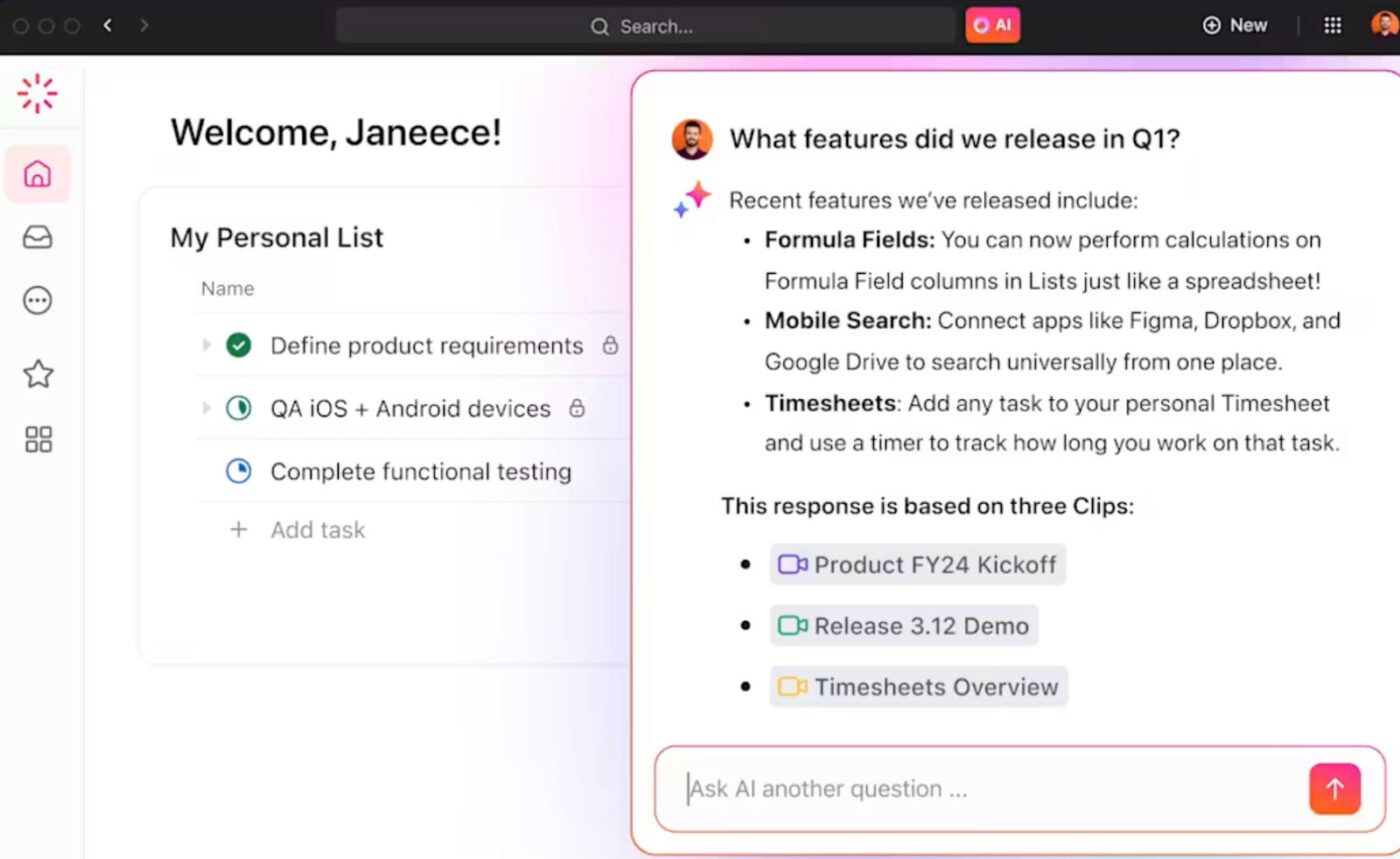
These AI‑driven insights can be converted into tasks or action items with minimal friction, making Clips more than just a recording tool.
📌 Example: Suppose your manager records a short Clip within a task or comment, explaining a new content strategy. When you open the Clip, you immediately see the auto‑generated transcript, complete with timestamps to guide you through key sections.
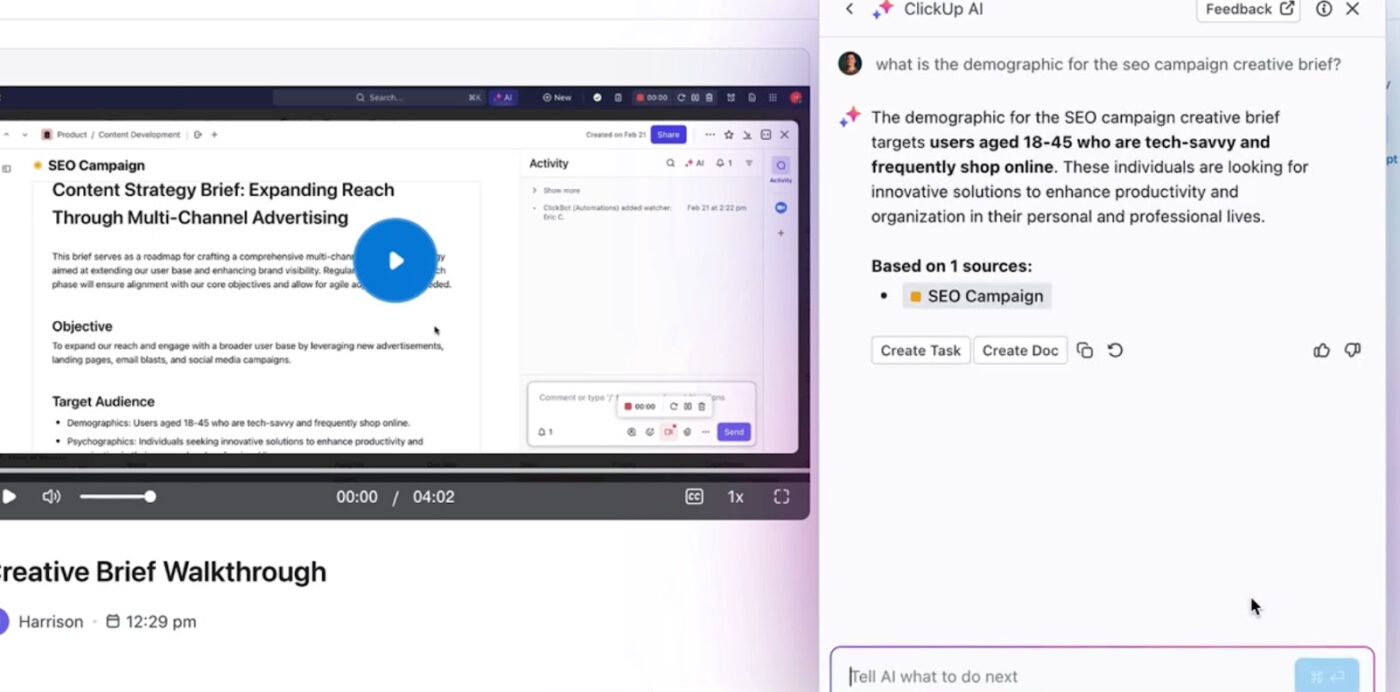
Now, if you’re pressed for time and don’t want to sit through the entire video, you can simply ask ClickUp Brain: What was the strategy for SEO?
Based purely on the spoken content of the Clip, the AI transcript summarizer returns a concise, accurate answer summarizing the SEO approach the manager described. You can convert these into tasks, assign team members, set due dates, and even link them to the relevant project list.
Now that you’ve reviewed the Clip, you want feedback from your team. With ClickUp Chat, you can seamlessly switch into a real-time conversation without needing to leave the work context.
Here’s how:
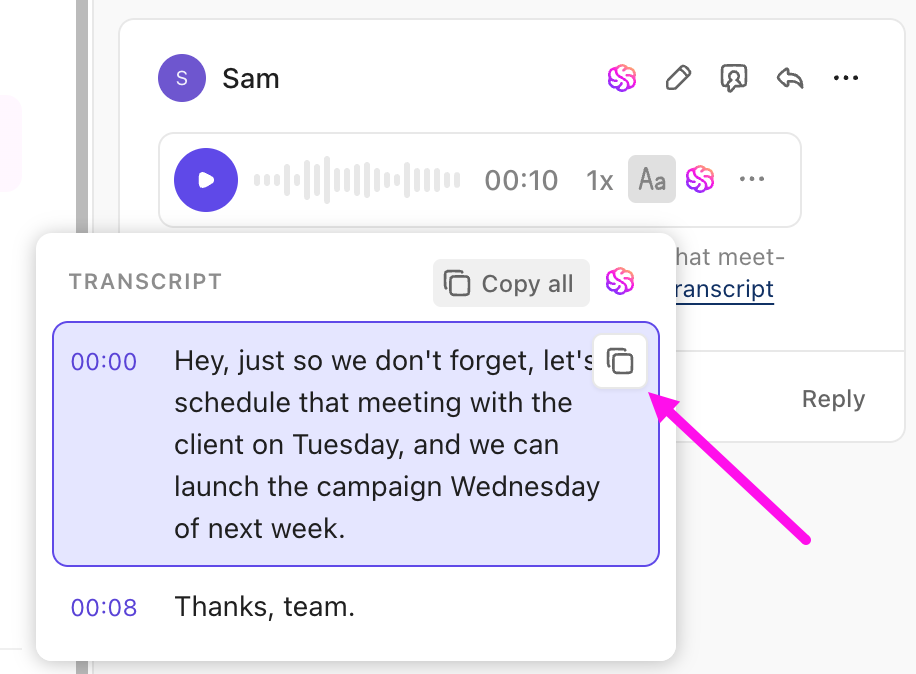
🔍 Did You Know? OpenAI’s Whisper model has shown a 1% hallucination rate—it invents whole sentences that never happened in the conversation. Worse, around 38% of those hallucinations include harmful or misleading content.
For live meetings, the ClickUp AI Notetaker takes over. It joins Zoom, Google Meet, or Teams automatically via your calendar. After the meeting, it generates:
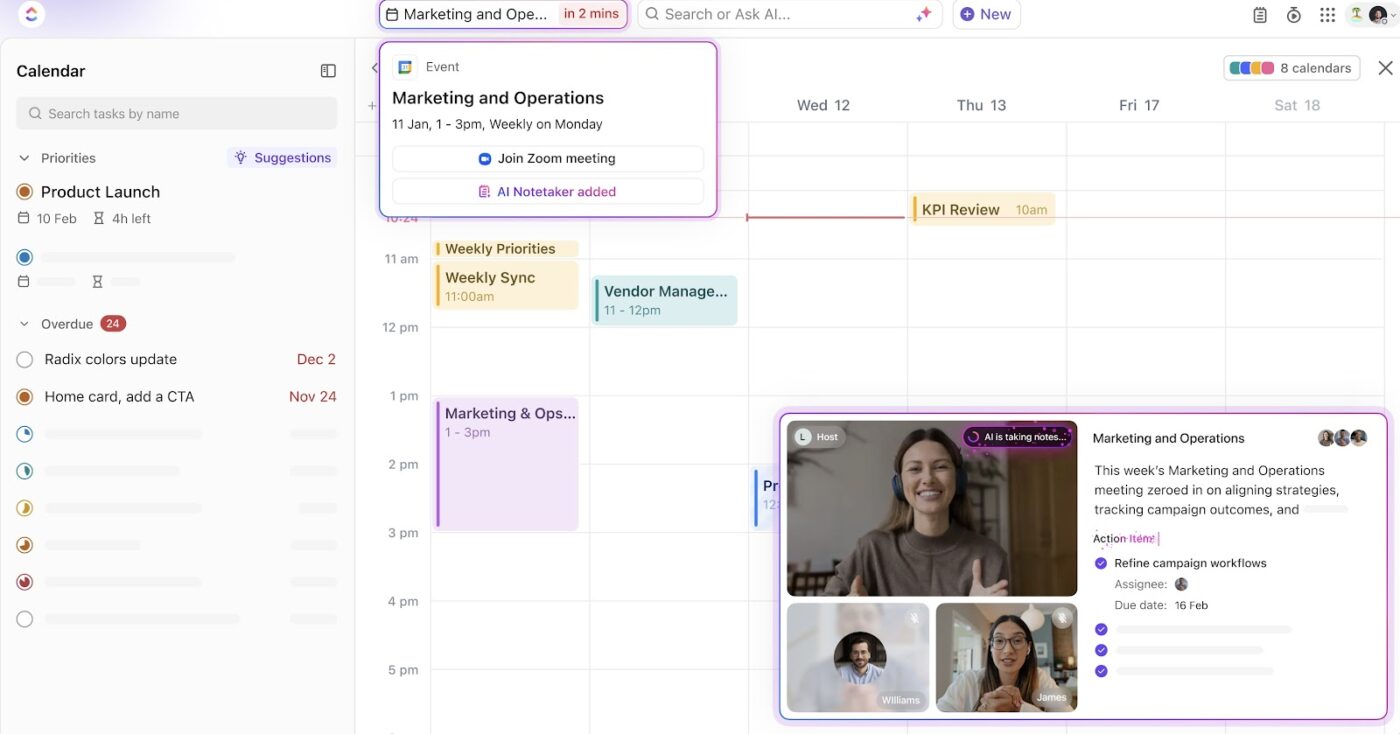
You can ask ClickUp Brain things like What did Sarah promise in our sprint planning call? and get an instant answer.
To structure your notes even faster, leverage ClickUp’s meeting notes templates, designed for everything from sprint planning and 1:1s to project kickoffs.
ClickUp Brain MAX takes voice-to-text way beyond transcription. It’s like having an AI co-pilot that understands your work and speaks your language.
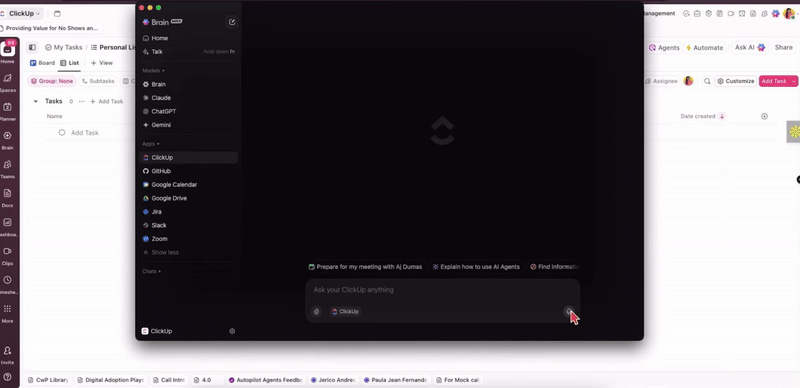
Here’s what makes Brain MAX different:
You can use Brain MAX by opening the desktop app and simply typing or speaking your request in the search bar. The AI searches across ClickUp, your connected apps, and the web to deliver instant answers and actions.
For example, you can ask, ‘Find the latest Figma files for the ABC marketing campaign,’ or use Talk to Text to quickly draft a message in any app on your computer.
Brain MAX lets you switch between ChatGPT, Claude, Gemini, and ClickUp’s own model. You can pick the best one for the job, so whether you’re summarizing a doc, translating a message, or brainstorming ideas, you get the sharpest output every time.
Ask Brain MAX: What’s on my plate today?
It’ll summarize your schedule and help book meetings, prep agendas, and generate recaps afterward.
See all the ways in which ClickUp Brain MAX can help you get the most out of your workday!
Slack’s speech-to-text features are a helpful start, especially for quick replies. But if you’re looking for more than just basic transcription, that’s where ClickUp takes the lead.
With ClickUp Brain, you get instant summaries, auto-generated action items, and AI that understands your work. Use ClickUp Chat to send voice notes, turn them into tasks, hold live calls, and keep everything in one thread.
Sign up for ClickUp and experience what AI-powered communication really feels like.
© 2025 ClickUp